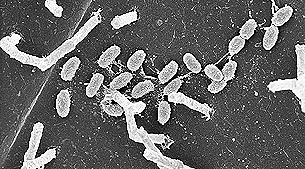Microbial Companions of Humans and Animals Are Highly Specialized

Microorganisms like these bacteria on the skin of a small crustacean are the constant companions of humans and animals. © University of Basel
It has long been known that almost all organisms have microbial companions. However, only about ten years ago did researchers find out that these bacterial communities are extremely rich in species. Humans and other mammals are often hosts to several thousand species, and even minute organisms like water fleas can carry over one hundred species.
This knowledge only became available by the use of genetic methods, that allowed researchers to sequence all genes of a single ecosystem (for example of the human intestine) at once. Data resulting from this method was also analyzed for the new study of the research group of Dieter Ebert, Zoologist from the Department of Environmental Sciences at the University of Basel.
Specialists or generalists?
The initial question was how specialized these microbes are. Since most bacteria only get recruited after their hosts' birth, one would assume that most of them are generalists. After all, microbes able to live in different environments and on a variety of hosts would have a significant advantage over specialists.
However, earlier studies had already shown that microbial communities differ between different hosts or habitats. However, why these differences occur was unknown. Some researchers assumed that even though hosts are colonized by several microbe species, only a few of them are successful.
The team of researchers around Dieter Ebert hypothesized that the successful microbes are specialists. Meaning that the successful species are those that prefer one specific host, where they then occur locally in great numbers. To test their thesis they developed a statistical method allowing them to align the relative abundance of a specific bacteria species with the degree of its local specificity.
They applied their new method to three very different data sets: Zooplankton from the Ägelsee pond, near Frauenfeld in Switzerland, different human habitats (such as ear, nose, mouth and arm pit) and a set from several ecosystems including water and sediment samples from fresh as well as salt water.
Specialists are more abundant locally
All three data sets revealed the same results: locally abundant microbes are local specialists. And vice versa: the smaller the relative abundance of one species, the more likely is it found in several habitats. Generalists are everywhere but nowhere in abundance, whereas specialists only occur abundant locally.
The journal Ecology Letters published the study financed by an Advanced Investigator Grant of the European Research Council today. The findings have far-reaching implications for our understanding of the structure of biodiversity in microbial ecosystems and they open the doors for further research of habitat-specific ecologic functions of microbes.
Original source
Mahendra Mariadassou, Samuel Pichon and Dieter Ebert
Microbial ecosystems are dominated by specialist taxa
Ecology Letters (2015), doi: 10.1111/ele.12478
Further information
Dieter Ebert, University of Basel, Department of Environmental Sciences, Zoology, phone +41 61 267 03 60/61, email: dieter.ebert@unibas.ch
https://www.unibas.ch/en/News-Events/News/Uni-Research/Microbial-Companions-of-H…
Media Contact
All latest news from the category: Life Sciences and Chemistry
Articles and reports from the Life Sciences and chemistry area deal with applied and basic research into modern biology, chemistry and human medicine.
Valuable information can be found on a range of life sciences fields including bacteriology, biochemistry, bionics, bioinformatics, biophysics, biotechnology, genetics, geobotany, human biology, marine biology, microbiology, molecular biology, cellular biology, zoology, bioinorganic chemistry, microchemistry and environmental chemistry.
Newest articles

Superradiant atoms could push the boundaries of how precisely time can be measured
Superradiant atoms can help us measure time more precisely than ever. In a new study, researchers from the University of Copenhagen present a new method for measuring the time interval,…

Ion thermoelectric conversion devices for near room temperature
The electrode sheet of the thermoelectric device consists of ionic hydrogel, which is sandwiched between the electrodes to form, and the Prussian blue on the electrode undergoes a redox reaction…

Zap Energy achieves 37-million-degree temperatures in a compact device
New publication reports record electron temperatures for a small-scale, sheared-flow-stabilized Z-pinch fusion device. In the nine decades since humans first produced fusion reactions, only a few fusion technologies have demonstrated…





















